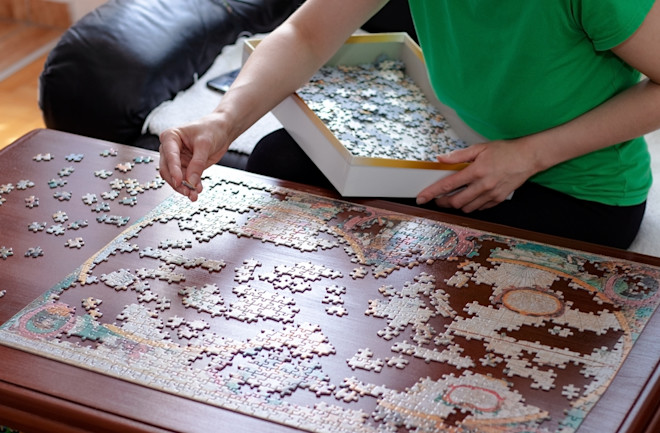When it comes to the great mathematical problems of the 21st century, the conundrums of jigsaws have been unjustly overlooked for too long. All that now changes thanks to the work of Madeleine Bonsma-Fisher, a data scientist at the University of Toronto and Kent Bonsma-Fisher, a quantum physicist, who have settled a problem that has bedeviled puzzlers the world over.
The question at the heart of their endeavor is this: if you have a jigsaw of N pieces that once assembled, fills an area equal to Aa, how much space do the unassembled pieces take up. Or in other words, “how big a table do you need for your jigsaw puzzle?”, which by mathematical coincidence, is the title of their paper on this subject. The answer, at least in one respect, turns out to be rather surprising.
Puzzle Pieces
The Bonsma-Fishers begin by calculating the approximate area of a single piece of the jigsaw Ap, which they point out is the area of the assembled puzzle divided by the number of pieces.
So Ap = Aa/N. And if this shape is approximately square, then each side has length √Ap = √(Aa/N)
They then imagine that in its unassembled state, the pieces are randomly arranged and so are distributed like circles with a diameter equal to their longest dimension.
This diameter is:
d = √(2Ap) = √(2Aa/N)
One way circles can pack into a plane is in a hexagonal pattern in which each circle is surrounded by 6 others. The researchers point out that there are three full circles inside one hexagonal element since each of the six edge circles contains 1/3 of the area of a circle, plus the one in the center. That means the area of a single circle takes up when it is packed in this way is 1/3 the area of the hexagon Ah.
So when there are N pieces, each taking up an area equivalent to Ah/3, they derive the following formula:
In other words, the area of the unassembled jigsaw is the area of the assembled puzzle multiplied by √3 ≈ 1.73. That’s surprising because it does not depend on N, the number of pieces.
So before assembly, a jigsaw cut into 20 pieces will take up the same space as the same jigsaw cut into 1000 pieces. The Bonsma-Fishers explain this with the following example.
“With a small number of large pieces, the gaps between pieces are larger (the hexagonal lattice spacing is larger), but this area is multiplied by a small number of pieces. Conversely, for many small pieces, the lattice spacing is smaller but there are more pieces,” they say. “Each lattice element is multiplied by N, but there is a factor of 1/N in the area of each lattice element; these cancel out, giving a final result independent of N.”
They go on to test this idea by measuring the size of various jigsaws in the assembled and unassembled states. “We found close agreement between realistic measurements and our theoretical prediction across a wide range of puzzle areas and numbers of pieces,” they say.
That’s interesting work, which could lead on from here. Imagine the same problem in three dimensions, perhaps with Lego blocks that must be assembled into a model or amino acids that must be assembled into a protein.
The question then becomes, what volume of space is needed to hold the unassembled pieces before they are put together?
Quantum Question
Taking the same approach, imagine that before assembly, each Lego block or amino acid is randomly oriented and so together they pack like spheres. The diameter of the sphere is equal to the diagonal of the cube the piece would fill. And so on…. We’ll leave it to the interested reader to calculate an answer or range of answers.
That may be useful for anyone transporting Lego bricks before they are assembled. It may even be useful for biologists studying the resources required for protein assembly, (although quantum search could play an important role in the assembly process, which might change the results given that quantum objects can share the same space).
But the biggest cheer will surely come from jigsaw fanatics who no longer need to guess the size of the table they need to assemble their puzzles.
Ref: How big a table do you need for your jigsaw puzzle? : arxiv.org/abs/2312.04588

